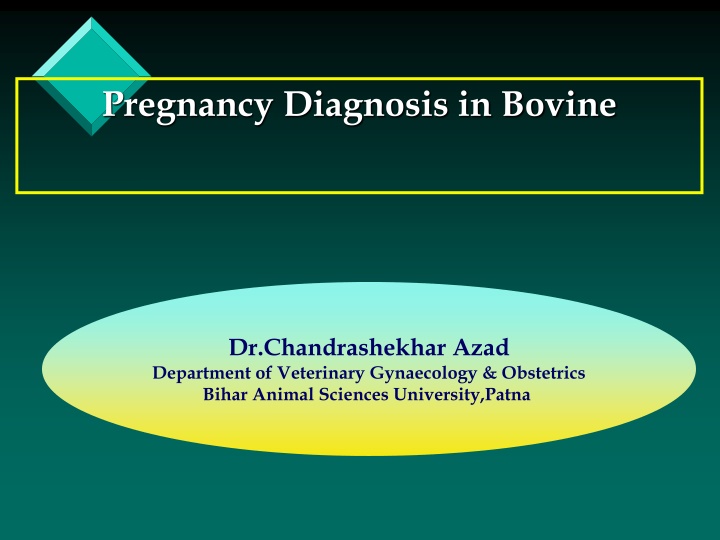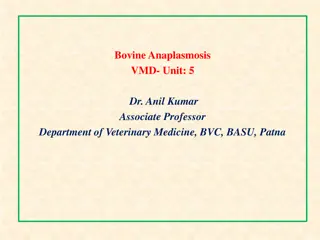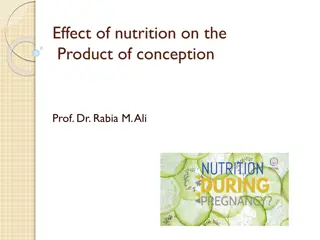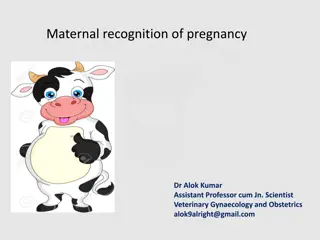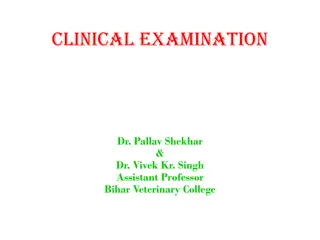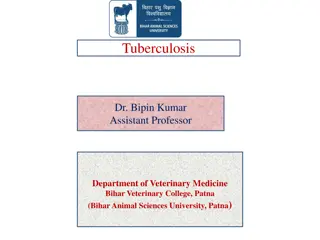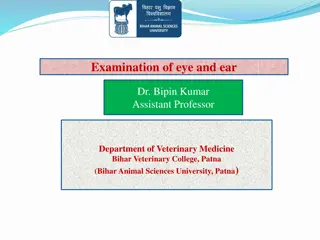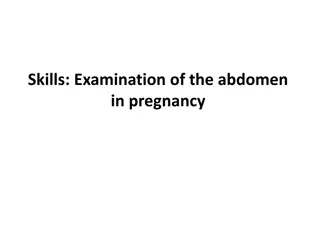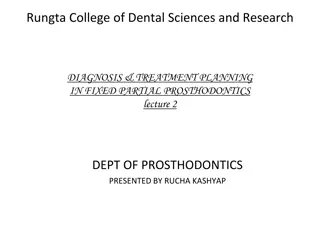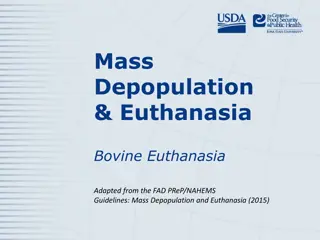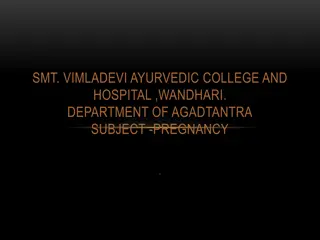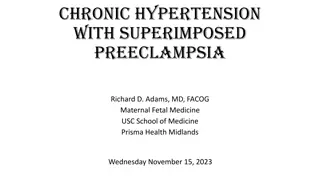Early Pregnancy Diagnosis in Bovine: Methods and Examination
Essential techniques for pregnancy diagnosis in bovine animals are detailed, including clinical palpation, radiography, lab tests, and external and internal examinations. Learn how to differentiate between pregnancy and abnormal conditions for successful breeding programs.
Download Presentation

Please find below an Image/Link to download the presentation.
The content on the website is provided AS IS for your information and personal use only. It may not be sold, licensed, or shared on other websites without obtaining consent from the author.If you encounter any issues during the download, it is possible that the publisher has removed the file from their server.
You are allowed to download the files provided on this website for personal or commercial use, subject to the condition that they are used lawfully. All files are the property of their respective owners.
The content on the website is provided AS IS for your information and personal use only. It may not be sold, licensed, or shared on other websites without obtaining consent from the author.
E N D
Presentation Transcript
Pregnancy Diagnosis in Bovine Dr.Chandrashekhar Azad Department of Veterinary Gynaecology & Obstetrics Bihar Animal Sciences University,Patna
Objective Early pregnancy diagnosis is essential for successful breeding programme. To differentiate the pregnancy and abnormal conditions of the uterus. To detect the pregnant and non pregnant animal.
Methods of pregnancy Diagnosis Sr. No. Method Cause Species Managemental Non return to oestrous Cattle, Buffalo, Sheep,Goat,Sow 1. Clinical Rectal Palpation Cattle, Buffalo, Sheep, Goat, Sow 2. Radiography Canine Sheep, Goat USG All species Abdominal palpation Canine Abdominal ballotment Cattle, Buffalo, Sheep, Goat Recto-abdominal Sheep Lab Test method Bacl 2,Cuboni Test Cattle, Buffalo,Mare 3. Lab method (Immunological) Progestrone, Estrogen All Species 4.
External Examination 1.Visual examination Fattening tendency of animal Increase in bodyweight Flanks become hollow and spine appears more prominent. Cessation of estrus cycle after A.I and natural service.
2.Abdominal ballottement: Abdominal ballottement of fetus can be done from 7 month onwards. Press abdomen right side by closed first and release suddenly and apply the palm against the abdominal wall to feel the fetus which hits the palm.
Internal Examination (Per rectal palpation) Advantage of P.D Provide immediate answer. Non pregnant cow treated early. Require minimum equipment and few person. Common errors in rectal palpation Failure to retract the uterus, abnormal uterine contents (pyometra and mucometra), incorrect service dates and Loss due to mishandling of uterus in early pregnancy diagnosis.
Changes observed during pregnancy by per rectal palpation. Palpation at 35-40 days. Uterus at pelvic floor. Asymmetry of uterine horn and amount of fluid 30-80 ml. Slipping of fetal membranes. Horn diameter- 4-5 cm ( 3 fingers) C.L on ipsilateral ovary
Palpation at 45-50 days Asymmetry of uterine horn and amount of fluid 80-100 ml. Pregnant horn diameter 5-6.5 cm( 4 fingers) Slipping of fetal membrane C.L on ipsilateral ovary
Palpation at 60 days Uterus slightly over the pelvic brim. Uterine horn feels like a balloon filled with water. Fetus mouse size ( 5 cm long) Pregnant uterus diam - 6.5 - 7.6 cm
Palpation at 90 days Pulled well over the pelvic brim. Pregnant horn diameter 8 -10 cm. Fetus 10-15 cm long. Placentomes ( 1-2 cm) may be palpated Pencil size middle uterine artery. Fetal bump present.
Palpation at 120 days Cervix pulled toward pelvic brim. Uterine horn diameter more than 18 cm. Fetus size 25-30 cm long. Small placentomes ( Cherry size) Fremitus prominent.
Palpation at 150 days Uterus at abdominal cavity. Placentomes ( walnut sized) Fetus size - 35-40 cm long Fremitus more prominent.
Palpation at 170-230days Dorsal wall of uterus tight and difficult to palpate. Placentomes difficult to palpate. Cervix at pelvic brim. Palpation at 230-280 days. Fetal head and limbs palpate. Fetal movement and reflexes can be felt.
Differential diagnosis Filled urinary bladder trace from cervix whether enlarged mass is in continuation with the cervix. Rumen feels like a doughy, flaccid mass whereas gravid uterus gives live feeling. Metritis ( Thick uterine wall, no fluid feeling, Foul smelling discharge) Mucometra No presence of fetus, Cotyldones absent.
Pregnancy Pyometra Dissimilar horns Similar horns except in cows where the uterine involution is not complete. Uterine wall thick. Uterine wall thin Live fluid feeling A thick fluid with no resilience. Double slipping fetus, placentomes palpable depending No such positive signs of pregnancy. Normal pregnancy Mummified fetus Presence of fetal fluids , placentomes and live fetus. Absence of fluid and placentomes and uterus tightly contracted over a semisolid to solid fetal mass. Mostly absent Fremitus present.
